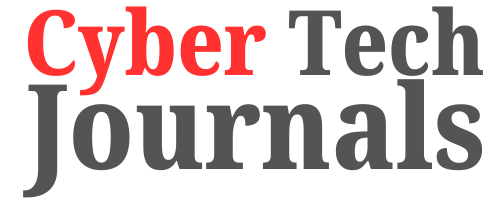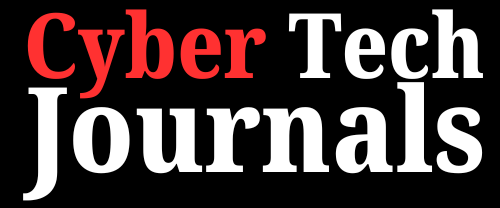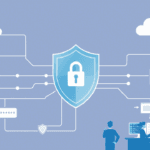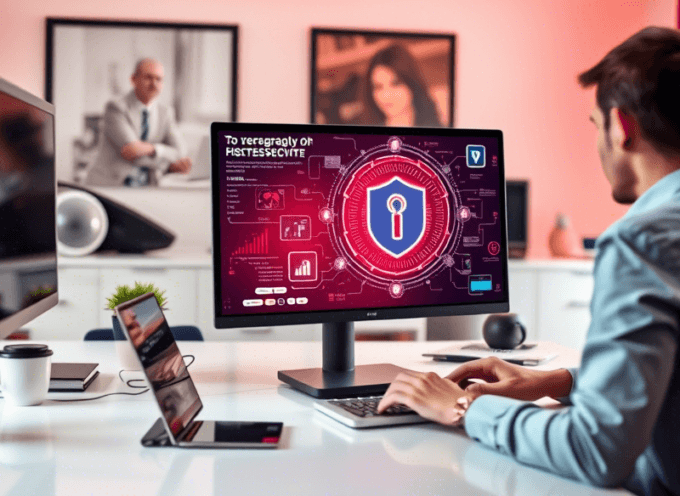Stay ahead of the curve by understanding the top 10 cybersecurity threats businesses will face in 2025. Learn actionable strategies to protect your organization and stay resilient against evolving cyber risks.
In today’s hyper-connected world, businesses are more reliant on digital systems than ever before. While this reliance has fueled innovation and efficiency, it has also opened the door to a rapidly evolving landscape of cybersecurity threats. According to Cybersecurity Ventures, global cybercrime damages are projected to exceed $10.5 trillion annually by 2025—a staggering figure that underscores the urgency for organizations to prioritize their cybersecurity efforts.
The latest trends indicate that cybercriminals are not only growing in number but are also leveraging cutting-edge technologies like artificial intelligence (AI), quantum computing, and deepfake technology to launch increasingly sophisticated attacks. A recent report by IBM’s Cost of a Data Breach Study revealed that the average cost of a data breach reached $4.45 million in 2023, marking a 15% increase over the past three years. This highlights the financial stakes for businesses failing to adapt to emerging threats.
To help you better understand the scope and scale of these threats, we’ve included tables and graphs throughout this article. These visual aids provide a snapshot of key data points and trends, making it easier to grasp the magnitude of the challenges ahead. Let’s dive in.
1. Ransomware Evolution
Ransomware continues to evolve, with attackers adopting more sophisticated tactics such as double or triple extortion. These involve encrypting data, threatening to release sensitive information, and launching DDoS attacks to pressure victims into paying ransoms. The rise of Ransomware-as-a-Service (RaaS) platforms has democratized access to ransomware tools, enabling even less-skilled attackers to launch devastating campaigns.
Latest Trends and Data:
| Year | Number of Ransomware Attacks | Percentage Increase |
|---|---|---|
| 2020 | 304 million | – |
| 2021 | 376 million | 23.7% |
| 2022 | 452 million | 20.2% |
Source: SonicWall’s 2023 Cyber Threat Report
Ransomware isn’t just a technical issue—it’s a business survival issue. A single attack can cripple operations, damage reputations, and lead to regulatory fines. For example, 60% of small businesses go out of business within six months of a ransomware attack. Without proper backups and defenses, your organization could face catastrophic losses.
Mitigation Strategies:
- Regular Backups: Ensure all critical data is backed up regularly and stored offline or in a secure cloud environment. Test your backups frequently to confirm they can be restored quickly in an emergency.
- Employee Training: Train employees to recognize phishing emails, which are often the entry point for ransomware attacks. Simulate phishing campaigns to identify weak spots in your team’s awareness.
- Endpoint Protection: Deploy advanced endpoint detection and response (EDR) tools that use AI to identify and block ransomware activity in real time.
2. AI-Powered Cyberattacks
Artificial intelligence is no longer just a tool for defenders—it’s also being weaponized by attackers. In 2025, AI-powered cyberattacks will become more common, enabling hackers to automate tasks, mimic legitimate behavior, and bypass traditional security measures. For example, AI-generated phishing emails are nearly indistinguishable from legitimate communications.
Latest Trends and Data:
| Type of Attack | Percentage of AI Use in 2023 | Projected Use by 2025 |
|---|---|---|
| Phishing Campaigns | 30% | 50% |
| Malware Development | 25% | 45% |
| Behavioral Mimicry | 20% | 40% |
Source: Symantec’s 2023 Threat Intelligence Report
AI-powered attacks are faster, smarter, and harder to detect. They exploit human psychology and system vulnerabilities at scale, leaving traditional defenses overwhelmed. Businesses that fail to adopt AI-driven security solutions risk falling behind in the arms race against cybercriminals.
Mitigation Strategies:
- AI-Driven Defenses: Fight fire with fire by deploying AI-based security solutions that can detect anomalies faster than humans can. These tools can analyze vast amounts of data to identify patterns indicative of an attack.
- Behavioral Monitoring: Use behavioral analytics to spot unusual activity, such as an employee suddenly accessing sensitive files they don’t normally interact with.
- Continuous Education: Keep employees informed about emerging AI-based threats and how to avoid falling victim to them.
3. IoT Vulnerabilities
The Internet of Things (IoT) has revolutionized industries, from smart homes to industrial automation. However, many IoT devices lack robust security features, making them easy targets for attackers. Once compromised, these devices can serve as gateways to larger networks, allowing hackers to steal data, launch DDoS attacks, or disrupt operations.
Latest Trends and Data:
| Sector | Percentage of IoT Breaches in 2023 |
|---|---|
| Healthcare | 28% |
| Manufacturing | 22% |
| Retail | 17% |
| Smart Homes | 15% |
| Transportation | 12% |
Source: Verizon’s 2023 Data Breach Investigations Report
IoT devices are everywhere, but their security is often an afterthought. A single compromised device can expose sensitive data or shut down critical operations. For instance, a 2022 breach exposed millions of smart home cameras, giving hackers the ability to spy on users remotely. Failing to secure IoT devices puts both consumer trust and operational continuity at risk.
Mitigation Strategies:
- Network Segmentation: Isolate IoT devices on separate networks to limit their access to critical systems. This way, even if a device is compromised, the damage is contained.
- Firmware Updates: Regularly update IoT device firmware to patch known vulnerabilities. Disable any unnecessary features that could introduce additional risks.
- Strong Authentication: Require multi-factor authentication (MFA) for all IoT devices and ensure default passwords are changed immediately.
4. Supply Chain Attacks
Supply chain attacks occur when attackers target third-party vendors to infiltrate larger organizations. Because businesses often trust their partners, these attacks can bypass traditional security measures and cause widespread damage.
Latest Trends and Data:
| Year | Percentage of Cyberattacks Involving Supply Chains |
|---|---|
| 2020 | 5% |
| 2021 | 10% |
| 2022 | 20% |
| 2023 | 35% |
| 2025 (Proj.) | 45% |
Source: Gartner’s Supply Chain Security Trends
Supply chain attacks highlight the interconnected nature of modern business ecosystems. A breach at one vendor can cascade across multiple organizations, amplifying the impact. For example, the SolarWinds attack in 2020 compromised thousands of organizations worldwide, including government agencies and Fortune 500 companies. If your business relies on third-party software or services, you’re vulnerable unless you take proactive steps to vet and monitor those relationships.
Mitigation Strategies:
- Vendor Vetting: Carefully assess the cybersecurity practices of all third-party vendors before partnering with them. Look for certifications like ISO 27001 or SOC 2 compliance.
- Zero Trust Architecture: Implement zero-trust principles, where every connection—internal or external—must be verified before granting access.
- Continuous Monitoring: Monitor interactions with third-party vendors for unusual activity, such as unauthorized data transfers or unexpected login attempts.
5. Deepfake Scams
Deepfakes—highly realistic fake videos or audio recordings—are being used for social engineering, impersonation, and spreading misinformation. These scams exploit human trust, making them particularly dangerous.
Latest Trends and Data:
| Year | Number of Deepfake Incidents Reported | Financial Losses (USD) |
|---|---|---|
| 2021 | 500 | $25 million |
| 2022 | 850 | $75 million |
| 2023 | 1,200 | $200 million |
Source: Wired’s Analysis of Deepfake Threats
Deepfakes blur the line between reality and deception, making it easier for attackers to manipulate employees, executives, and customers. For example, a 2023 incident involved a deepfake video of a CEO ordering wire transfers, tricking employees into sending $243,000 to fraudsters. Without verification protocols and detection tools, businesses risk falling victim to costly scams.
Mitigation Strategies:
- Verification Protocols: Establish strict verification procedures for high-value transactions, such as requiring verbal confirmation through a secondary channel.
- Detection Tools: Invest in deepfake detection technologies to identify manipulated content. Educate employees about the existence and dangers of deepfakes.
- Policy Updates: Update internal policies to address deepfake-related risks, ensuring everyone knows what to do if they suspect foul play.
6. Quantum Computing Risks
Quantum computers have the potential to break traditional encryption methods, rendering current security protocols obsolete. While practical quantum computers are still years away, nation-states and cybercriminals are already stockpiling encrypted data to decrypt once quantum capabilities mature.
Latest Trends and Data:
| Encryption Algorithm | Time to Break (Current Tech) | Time to Break (Quantum Tech) |
|---|---|---|
| RSA-2048 | Centuries | Minutes |
| ECC-256 | Billions of Years | Seconds |
Source: NIST’s Post-Quantum Cryptography Project
Quantum computing poses a long-term threat to data security. Organizations storing sensitive data today may find it exposed in the future if they don’t transition to quantum-resistant encryption. Preparing now ensures your business remains secure in the post-quantum era.
Mitigation Strategies:
- Post-Quantum Cryptography: Transition to quantum-resistant encryption algorithms, such as those being developed under NIST’s Post-Quantum Cryptography Standardization Project.
- Stay Informed: Keep up with advancements in quantum technology and collaborate with industry leaders to prepare for the post-quantum era.
- Data Retention Policies: Limit the amount of sensitive data you retain long-term to reduce exposure to future quantum attacks.
7. Cloud Security Breaches
As more businesses migrate to the cloud, misconfigurations and inadequate security measures have led to an increase in breaches. Attackers exploit weak permissions, unsecured APIs, and poorly managed credentials to gain unauthorized access.
Latest Trends and Data:
| Year | Number of Cloud Breaches | Financial Losses (USD) |
|---|---|---|
| 2021 | 500 | $5 billion |
| 2022 | 750 | $10 billion |
| 2023 | 1,000 | $15 billion |
Source: McAfee’s Cloud Adoption and Risk Report
Cloud adoption offers scalability and flexibility, but without proper security measures, it exposes businesses to significant risks. Misconfigured cloud storage, for example, led to the Capital One breach in 2019, costing the company millions. Ensuring robust cloud security is essential for protecting sensitive data.
Mitigation Strategies:
- Multi-Factor Authentication (MFA): Require MFA for all cloud accounts to add an extra layer of protection.
- Encryption: Encrypt sensitive data both in transit and at rest to prevent unauthorized access.
- Regular Audits: Conduct regular audits to ensure proper configuration settings and identify potential vulnerabilities.
8. Insider Threats
Insider threats—whether malicious or accidental—pose a significant risk to businesses. Employees, contractors, or partners may intentionally steal data or inadvertently expose it through negligence.
Latest Trends and Data:
| Type of Insider Threat | Percentage of Total Breaches (2023) |
|---|---|
| Malicious Insiders | 45% |
| Negligent Employees | 35% |
| Compromised Credentials | 20% |
Source: Ponemon Institute’s Insider Threat Report
Insider threats are often overlooked but can be just as damaging as external attacks. For example, Tesla’s insider sabotage incident in 2018 caused reputational damage and legal headaches. Addressing insider risks requires a combination of technology, policy, and culture.
Mitigation Strategies:
- Least Privilege Access: Grant employees access only to the resources they need to perform their jobs.
- Activity Monitoring: Use tools to monitor user activity and flag suspicious behavior, such as downloading large amounts of data or accessing files outside normal working hours.
- Cultural Awareness: Foster a culture of accountability and transparency, encouraging employees to report suspicious activities without fear of retribution.
9. Phishing 2.0
Phishing has evolved beyond generic emails to include highly targeted spear-phishing campaigns and AI-generated messages that mimic legitimate communications. These attacks prey on human psychology, making them difficult to detect.
Latest Trends and Data:
| Year | Number of Phishing Attacks | Success Rate (%) |
|---|---|---|
| 2021 | 1.2 billion | 20% |
| 2022 | 1.6 billion | 25% |
| 2023 | 2.1 billion | 30% |
Source: Proofpoint’s Phishing Trends Report
Phishing remains one of the most common attack vectors because it exploits human error. As attackers refine their techniques, businesses must invest in both technology and training to reduce susceptibility.
Mitigation Strategies:
- Simulated Attacks: Conduct regular phishing simulations to test employee readiness and identify areas for improvement.
- Email Filtering: Deploy advanced email filtering solutions that use machine learning to block suspicious messages.
- Reporting Mechanisms: Encourage employees to report suspicious emails promptly so IT teams can investigate and respond quickly.
10. Zero-Day Exploits
Zero-day exploits occur when attackers discover and exploit unknown vulnerabilities before developers can patch them. These attacks leave no time for preparation, making them particularly dangerous.
Latest Trends and Data:
| Year | Number of Zero-Day Exploits | Average Time to Patch (Days) |
|---|---|---|
| 2021 | 58 | 60 |
| 2022 | 76 | 55 |
| 2023 | 91 | 50 |
Source: CISA’s Zero-Day Vulnerability Guidance
Zero-day exploits are unpredictable and challenging to defend against. The Log4j vulnerability in 2021 highlighted how quickly attackers can exploit newly discovered flaws. Businesses must adopt proactive measures to minimize exposure.
Mitigation Strategies:
Threat Intelligence: Collaborate with threat intelligence platforms to stay informed about emerging vulnerabilities and proactive mitigation techniques.
Summary
Patch Management: Stay updated on patches and apply them immediately to minimize exposure.
Intrusion Detection Systems (IDS): Use IDS to identify unusual activity that could indicate a zero-day exploit.
As we look ahead to 2025, the cybersecurity landscape is poised to become even more complex and challenging. From ransomware evolution to quantum computing risks, businesses must remain vigilant and proactive to protect themselves from emerging threats. By implementing robust security measures, fostering a culture of awareness, and investing in cutting-edge tools, you can safeguard your organization from even the most sophisticated attacks.
Ready to take action? Download our free Cybersecurity Preparedness Checklist to get started on strengthening your defenses. And don’t forget to subscribe to our newsletter for weekly updates on the latest cybersecurity trends and actionable insights. Together, let’s build a safer digital future.

















Leave a comment